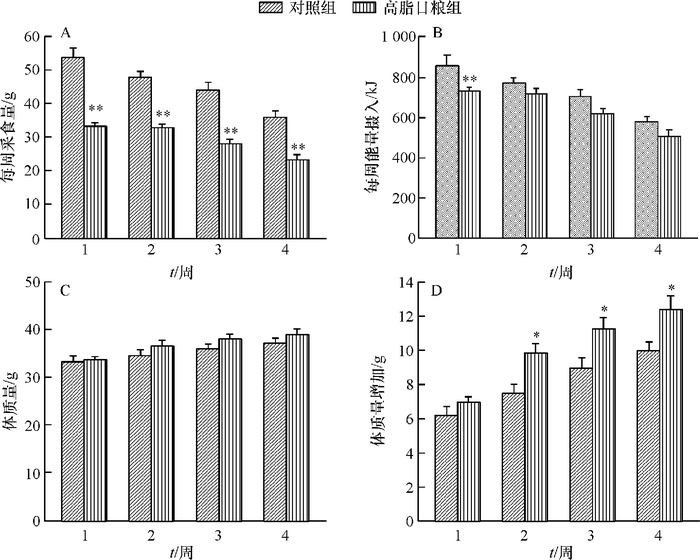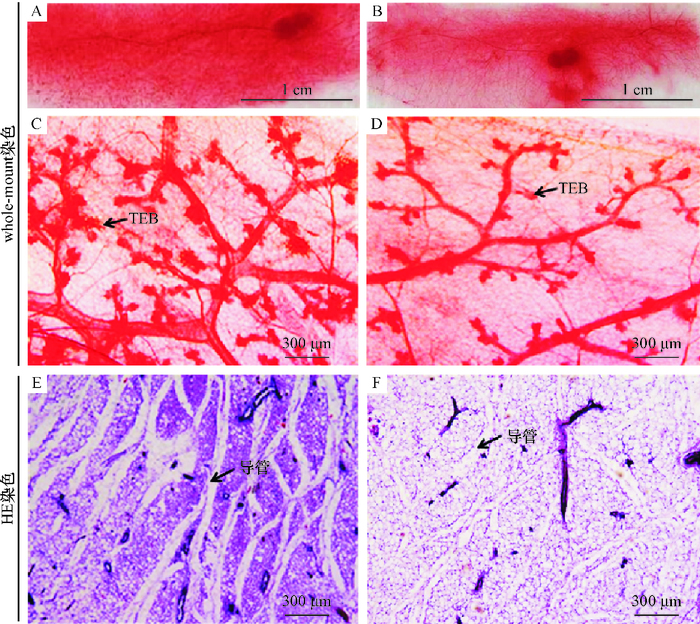Effect of high-fat diet on mammary gland development of pubertal mice and the molecular mechanism
-
摘要:目的
研究高脂日粮对初情期小鼠乳腺发育的影响及可能机制。
方法选用20只4周龄昆明雌性小鼠,设对照组和高脂日粮组,试验期4周,每周称体质量并统计采食量。试验结束后采集小鼠乳腺并称质量,采用whole-mount及HE染色观察小鼠乳腺组织形态结构及导管数量。利用Western blot检测初情期小鼠乳腺组织胰岛素样生长因子1(Insulin-like growth factor1, IGF-1)、增殖相关信号通路关键蛋白蛋白激酶B(Protein kinase B, Akt)、胞外调控的蛋白激酶(Extracellular regulated protein kinase, ErK)以及炎症信号通路关键蛋白Toll样受体4(Toll-like receptor 4, TLR4)、c-Jun氨基末端激酶(c-Jun N-terminal kinase, JNK)和核因子κB激酶抑制剂(Inhibitor of nuclear factor kappa-B kinase, IKK)的表达。
结果高脂日粮组小鼠采食量极显著低于对照组(P < 0.01),但在能量摄入方面与对照组无显著差异。高脂日粮组小鼠的体质量增加显著高于对照组(P < 0.05)。高脂日粮组小鼠在乳腺质量、乳腺质量与体质量的比值上均极显著高于对照组(P < 0.01)。乳腺组织的whole-mount及HE染色结果表明,高脂日粮组小鼠乳腺导管发育明显被抑制,其乳腺组织的导管数和密度明显降低,乳腺组织的终末乳芽数量也极显著低于对照组(P < 0.01)。高脂日粮能够显著抑制小鼠乳腺组织IGF-I的蛋白表达以及Akt、Erk和IKK的磷酸化水平(P < 0.01或0.05),极显著促进小鼠乳腺组织TLR4的蛋白表达(P < 0.01) 和显著促进JNK的磷酸化水平(P < 0.05)。
结论高脂日粮能够抑制初情期小鼠乳腺发育,这可能是通过抑制乳腺增殖的相关信号和促进乳腺组织炎症的相关信号来实现。
Abstract:ObjectiveTo investigate the effect of high-fat diet (HFD) on mammary gland development of pubertal mice and explore the possible underlying mechanisms.
MethodTwenty 4-week-old Kunming female mice were randomly divided into control group and HFD group. The trial lasted for four weeks. The body weight and feed intake were recorded weekly. At the end of the trial, mammary glands were collected and weighed. The morphology and number of ducts were observed by using whole-mount and HE staining. Western blot was used to analyze the expressions of insulin-like growth factor 1 (IGF-1), proliferation related signaling pathway proteins such as protein kinase B (Akt) and extracellular regulated protein kinases (ErK), as well as inflammation related signaling pathway proteins, including toll-like receptor 4 (TLR4), c-Jun N-terminal kinase (JNK) and inhibitor of nuclear factor kappa-B kinase (IKK) in the mammary glands.
ResultThe feed intake of the HFD group was significantly lower than that of control group(P < 0.05), There was no significant difference in energy intakes between two groups. The body weight gain of HFD group was significantly higher than that of control group (P < 0.05). In addition, HFD significantly increased mammary gland weight and the ratio of mammary gland weight to body weight (P < 0.01). The results of whole-mount and HE staining demonstrated that the mammary gland development of HFD group mice were markedly inhibited, with significantly decreased duct number, duct density and number of terminal end buds (P < 0.01). HFD significantly inhibited IGF-1 expression and the phosphorylation of Akt, Erk and IKK in mammary glands (P < 0.01 or 0.05), while significantly promoted TLR4 expression (P < 0.01) and JNK phosphorylation (P < 0.05).
ConclusionHFD can suppress mammary gland development of pubertal mice, which might result from the inhibiton of proliferative signals and stimulation of inflammatory signals.
-
Keywords:
- high-fat diet (HFD) /
- mouse /
- mammary gland development /
- proliferation /
- inflammation /
- protein expression
-
表 1 对照组和高脂日粮组日粮成分对比
Table 1 Comparison of dietary composition for control group and high-fat diet group
成分 日粮质量/kg 日粮能量/kJ 对照组 高脂日粮组 对照组 高脂日粮组 酷蛋白(80 Mesh) 189.56 258.51 3 172.56 4 325.38 L-胱氨酸 2.84 3.88 47.57 64.89 玉米淀粉 298.56 0 4 996.78 0 麦芽糊精10 33.17 161.57 555.22 2 703.37 蔗糖 331.74 88.67 5 551.96 1487.91 纤维素BW200 47.39 64.63 0 0 豆油 23.70 32.31 892.28 1 216.50 猪油 18.96 316.68 713.83 11 921.85 复合矿物质S10026 9.48 12.93 0 0 磷酸氢钙 12.32 16.80 0 0 碳酸钙 5.21 7.11 0 0 柠檬酸钾(1 H2O) 15.64 21.33 0 0 复合维生素V10001 9.48 12.93 158.62 216.27 重酒石酸氢胆碱 1.90 2.59 0 0 FD & C蓝色染料#1 0.05 0.06 0 0 总计 1 000.00 1 000.00 16 088.82 21 936.17 表 2 高脂日粮对初情期小鼠乳腺(第4对)质量和终末乳芽数量的影响1)
Table 2 Effects of high-fat diet on mammary gland (the fourth pair) weight and the number of terminal end bud of pubertal mice
组别 乳腺质量/g 乳腺质量:体质量 TEB 对照组 0.206±0.006 0.53±0.000 3 81±2.41 高脂日粮组 0.357±0.037** 0.97±0.001 3** 29±2.42** 1) **表示与对照组相比差异达到0.01的显著水平(t检验) -
[1] FARMER C. Review: Mammary development in swine: Effects of hormonal status, nutrition and management[J]. Can J Anim Sci, 2013, 93(1): 1-7. doi: 10.4141/cjas2012-066
[2] MACIAS H, HINCK L. Mammary gland development[J]. Wiley Interdiscip Rev Dev Biol, 2012, 1(4): 533-557. doi: 10.1002/wdev.v1.4
[3] REZAEI R, WU Z, HOU Y, et al. Amino acids and mammary gland development: Nutritional implications for milk production and neonatal growth[J]. J Anim Sci Biotechno, 2016, 7(20). doi: 10. 1186/s40104-016-0078-8.
[4] FARMER C, PALIN M F, MARTEL-KENNES Y. Impact of diet deprivation and subsequent over-allowance during prepuberty: Part 1: Effects on growth performance, metabolite status, and mammary gland development in gilts[J]. J Anim Sci, 2012, 90(3): 863-871. doi: 10.2527/jas.2011-4131
[5] ZHAO Y, TAN Y S, AUPPERLEE M D, et al. Pubertal high fat diet: Effects on mammary cancer development[J]. Breast Cancer Res, 2013, 15(5): R100. doi: 10.1186/bcr3561
[6] 李健, 李庆章.小鼠乳腺发育、泌乳和退化的组织形态学:Ⅰ:一般组织形态学变化[J].东北农业大学学报, 2007, 38(2): 196-201. http://www.cnki.com.cn/Article/CJFDTOTAL-DBDN200702012.htm [7] 李健, 李庆章.小鼠乳腺发育、泌乳和退化的组织形态学:Ⅱ:超微组织形态学变化和β-酪蛋白分泌[J].东北农业大学学报, 2007, 38(3): 374-379. http://www.cnki.com.cn/Article/CJFDTOTAL-DBDN200703021.htm [8] MASUYAMA H, HIRAMATSU Y. Additive effects of maternal high fat diet during lactation on mouse offspring[J]. PLoS One, 2014, 9(3): e92805. doi: 10.1371/journal.pone.0092805
[9] MONTALES M T E, MELNYK S, SIMMEN R. Maternal high fat diet promotion of mammary tumor risk in adult progeny is associated with early expansion of mammary cancer stem-like cells and increased maternal oxidative environment[J]. FASEB J, 2013, 27(Suppl 1): 235. 2. doi: 10.1007/978-1-4939-6386-7_13/fulltext.html
[10] KAMIKAWA A, ICHII O, YAMAJI D, et al. Diet-induced obesity disrupts ductal development in the mammary glands of nonpregnant mice[J]. Dev Dynam, 2009, 238(5): 1092-1099. doi: 10.1002/dvdy.v238:5
[11] MATSUBARA T, MITA A, MINAMI K, et al. PGRN is a key adipokine mediating high fat diet-induced insulin resistance and obesity through IL-6 in adipose tissue[J]. Cell Metab, 2012, 15(1): 38-50. doi: 10.1016/j.cmet.2011.12.002
[12] MCFARLANE M R, BROWN M S, GOLDSTEIN J L, et al. Induced ablation of ghrelin cells in adult mice does not decrease food intake, body weight, or response to high-fat diet[J]. Cell Metab, 2014, 20(1): 54-60. doi: 10.1016/j.cmet.2014.04.007
[13] OLSON L K, TAN Y, ZHAO Y, et al. Pubertal exposure to high fat diet causes mouse strain-dependent alterations in mammary gland development and estrogen responsiveness[J]. Int J Obes (Lond), 2010, 34(9): 1415-1426. doi: 10.1038/ijo.2010.51
[14] TIAN J, BERTON T R, SHIRLEY S H, et al. Developmental stage determines estrogen receptor alpha expression and non-genomic mechanisms that control IGF-1 signaling and mammary proliferation in mice[J]. J Clin Invest, 2012, 122(1): 192-204. doi: 10.1172/JCI42204
[15] BODEN G, SHE P, MOZZOLI M, et al. Free fatty acids produce insulin resistance and activate the proinflammatory nuclear factor-kappaB pathway in rat liver[J]. Diabetes, 2005, 54(12): 3458-3465. doi: 10.2337/diabetes.54.12.3458
[16] ZHANG X, ZHANG G, ZHANG H, et al. Hypothalamic IKKbeta/NF-kappaB and ER stress link overnutrition to energy imbalance and obesity[J]. Cell, 2008, 135(1): 61-73. doi: 10.1016/j.cell.2008.07.043
[17] COWEN S, MCLAUGHLIN S L, HOBBS G et al. High-fat, high-calorie diet enhances mammary carcinogenesis and local inflammation in MMTV-PyMT mouse model of breast cancer[J]. Cancers, 2015, 7(3): 1125-1142. doi: 10.3390/cancers7030828
[18] SONG X, GUO M, WANG T et al. Geniposide inhibited lipopolysaccharide-induced apoptosis by modulating TLR4 and apoptosis-related factors in mouse mammary glands[J]. Life Sci, 2014, 119(1): 9-17. https://www.ncbi.nlm.nih.gov/pubmed/?term=Geniposide+Inhibited+Lipopolysaccharide-induced+Apoptosis+by+Modulating+TLR4+and+Apoptosis-related+Factors+in+Mouse+Mammary+Glands
[19] CELLURALE C, GIRNIUS N, JIANG F et al. Role of JNK in mammary gland development and breast cancer[J]. Cancer Res, 2012, 72(2): 472-481. doi: 10.1158/0008-5472.CAN-11-1628
[20] CAO Y, KARIN M. NF-kappaB in mammary gland development and breast cancer[J]. J Mammary Gland Biol Neoplasia, 2003, 8(2): 215-223. doi: 10.1023/A:1025905008934




 下载:
下载:


